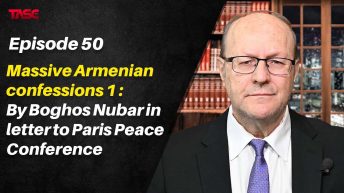In Episode 43, we have learned that Professor Justin McCarthy had discovered in the US National Archives in 1990, a survey of eastern Anatolia conducted in the summer of 1919 by two Americans, Captain Emory H. Niles, and Mr. Arthur E. Sutherland Jr. Some 20 years after that momentous discovery, Niles and Sutherland’s field notes have been found in the archives of the former American Board of Commissioners for Foreign Missions (ABCFM) in Istanbul, by another American historian, Brian Johnson. In Episodes 44 and 45, I covered Johnson’s research work titled “Americans Investigating Anatolia: The 1919 Field Notes of Emory Niles and Arthur Sutherland.” Between 14 July and 12 August 1919, Emory Niles and Arthur Sutherland, employees of the aid organization called The American Committee for Relief in the Near East, or the Near East Relief for short, traveled from Mardin to Trabzon, by way of Bitlis, Van, and Erzurum, visiting 23 cities, to determine their relief needs of the locals and how the Near East Relief could fulfill them. Their report was somehow mixed in among various papers related to the Major General James G. Harbord Commission—a survey expedition sent by President Wilson to Anatolia and the South Caucasus in September 1919 to investigate the feasibility for an American mandate over the region and the establishment of an Armenian state that would include most of eastern Turkey. Harbord relied in his report on Niles & Sutherland’s report on Bitlis and Van, but distorted that report by implying that they were similar to Harbord’s findings, which they were absolutely not. The ABCFM, a Protestant mission agency founded in 1810 to spread Protestant teachings worldwide, first appeared in Anatolia in 1820. Finding Muslims inaccessible, the missionaries turned their attention to Christians of the Eastern Churches. By the 1850s, the ABCFM had already built an extensive network of schools and hospitals. The outbreak of the WWI interrupted missionary activities abruptly, although the US did not enter the WWI for almost three years. It did not help that the Armenians, in whom the missionaries invested most, deserted from the Ottoman army when the Ottoman Empire was fighting for its survival against multiple foreign attacks. To make matters worse, the Armenians joined the invading enemy armies of the Tsarist Russia. To add insult to injury, the Armenian turncoats waged massive armed rebellions in eastern Anatolia tying up Ottoman soldiers desperately needed at other fronts. Here is what The Macmillan Dictionary of The First World War, by Pope & Wheal, published in London, in 1997 says on Page 34: “…(Armenian nationalists) invaded (eastern Anatolia) in December and slaughtered an estimated 120,000 non-Armenians while the Turkish Army was preoccupied with mobilization and the Caucasian front offensive toward Sarikamish…” Armenian insurgents killed another 80,000 Muslims during the Van rebellion in April-May of 1915, ethnically cleansing the entire area of its Muslims. The two casualty numbers alone add up to 200,000 Muslim dead, representing about 2 % of the Ottoman Muslims. Niles and Sutherland recorded massive Muslim losses of life and property, after interviewing local officials and inhabitants. Russians and Armenians had occupied Van, along with much of Eastern Anatolia between May 1915 and March 1917 when the Russian army left due to revolution at home. That is when Armenian atrocities victimizing defenseless Muslims peaked and lasted from 1917 to 1918. According to Johnson, “…The Muslim quarter (in Bitlis)was in total ruin, with an estimated 6,500 homes lost. Mosques, shops, public buildings, and bridges had also been wrecked…The same general conditions were evident throughout the region…” In the province of Van, 150,000 Muslims from a pre-war population of 301,000 remained. Lesser damage observed in Armenian villages. Niles and Sutherland heard shocking stories where the Armenians were accused of having committed murder, rape, arson, torture, and other horrible atrocities of every description upon the Muslim population. Missionary accounts and the US press heavily publicized a stereotypical view, shaping the American public opinion about events in Anatolia before, before, during, and after World War I. Niles and Sutherland’s findings contradicted this outlook.
Myths and Realities




Add comment